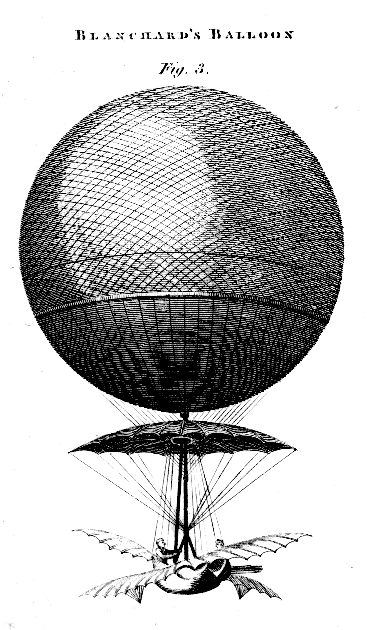|
|

First Manned Balloon Across the English Channel
|
Share This Page
|
|
|
|
|
|
|
Follow This Site

|
 |
|
|
|
|

|
The first balloon flight across the English Channel was the result of a collaboration between an inventive Frenchman and an enterprising American. The Frenchman was Jean Pierre Francois Blanchard, whose experiments in heavier-than-air flying machines had led him initially to design a machine that used oars and tiller. The American was John Jeffries, a doctor who was convinced that flying was good for one's health. Together, they made history, on January 7, 1785, flying from Dover, England, to Calais, France.

The flight was not without incident. First of all, Jeffries had hired Blanchard to transport him across the Channel. They didn't have a common language but managed to disagree on the price of the fare anyway. Then, over the water, the balloon unexpectedly lost a lot of hot air and almost dropped into the Channel. The two desperate men threw nearly everything overboard that they absolutely didn't need, including much of their clothes, and they eventually made it across. It took them 2 hours and 25 minutes. The only thing that survived the trip, other than themselves, was a package to be delivered in France. Thus, this was the first example of international air mail as well.
Blanchard first took to the air in a balloon he built he himself on March 2, 1784. His imagination was fired by the balloon demonstration of the Montgolfier brothers (Joseph and Jacques), who put on a display in Annonay, France, in 1783. Blanchard, a scientist and inventor, improved on the Montgolfiers' design and made one that could sustain flight. His failed experiments to create a manually powered airplane and helicopter foreshadowed the Wright Brothers' success nearly a century later. Blanchard was also the first to experiment with parachutes, jumping with one himself for a successful landing.
Footnotes
- After his success flying across the Channel, Blanchard went on to become the first to fly a balloon in other countries, including the United States, Germany, Belgium, Poland, and the Netherlands. His wife, Marie, often accompanied him on these flights. It was on one of his flights over The Hague that he died, suffering a heart attack and falling more than 50 feet to his death.
- Jeffries faded into obscurity after his famous flight.
|
|